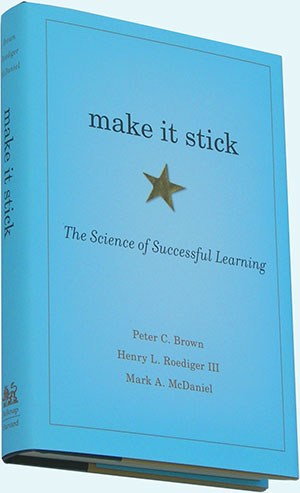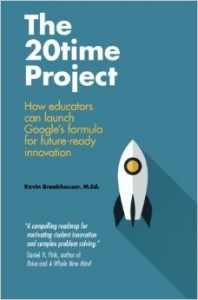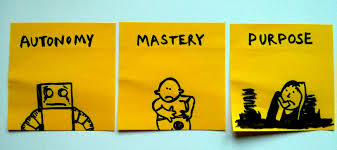Last night, I participated in a lively #whatisschool Twitter chat. The discussion topic at hand: Autonomy.
One of the questions puzzled me: “How do you develop a culture of autonomy in the classroom?” Right now, I feel autonomy is a weakness in my classroom. In my school for that matter.
So I’ve continued pondering this question. Why do I want autonomy? Because I want my students to have investment in their learning and search for answers on their own, so they can better problem solve in the future.
But how do I encourage student investment?
I circled back to a recent Cult of Pedagogy podcast with Make It Stick co-author Peter Brown, where he talked about generation: the idea that students try (and struggle with) a problem/concept/challenge first before learning from a teacher/coach/mentor.
Brown gave the example of when he learned about short story writing. Sure, he could have gone to a writing class first, learned the basics, and then went home to draft it. Instead, he drafted a story first, then went to a writing class.
The difference? Brown says he gained much more from the class. He already had some experience and encountered some problems in his writing. In the class, he was able to immediately apply his learning to the draft he’d already worked on.
Make It Stick is a fantastic book (I highly recommend!) about making learning stick with students, but I also think this plays into student investment. Instead of starting with direct instruction, letting kids “get their hands dirty” first is more effective both in learning–and in investment. If students struggle with a problem, they gain background knowledge and develop questions in their minds–questions you can then answer through direct instruction. Without the struggle, students don’t retain the direct instruction as well, and you’ll likely end up answering questions that you already addressed in the direct instruction.
Think about some real life examples where we let kids struggle.
–Swimming. We don’t keep kids on the pool deck until we go over all parts of swimming. We put them in the water, let them get the feel of movement, watch them struggle with trying to float and swim on their own. Only when they have that background knowledge, we start teaching them how to swim.
–Web Apps. When testing out a new web app, I’d much rather play around first, test different buttons, and then watch some of the tutorial videos and read the FAQs. Only then will I tweet or email others with questions.
-Sweeping. My own kids just wanted to jump in and sweep the kitchen floor without any instruction. You can imagine the result: tons of crumbs and dust in the corners and crevices. But when they finished and I showed them the detritus they’d missed, they see that their own technique wasn’t good enough and were willing to add on my suggestions.
One of the keys is safety–both literal and figurative. A shop teacher wouldn’t allow students to play with a table saw before they learned the safety rules. Nor would I expect a struggling writer to complete an entire research paper before teaching them the guidelines to research. Doing so would result in such frustration that I’d likely never rebuild rapport with that student.
To practice generation–this idea of giving kids a chance to experience and struggle before learning from a mentor/teacher/coach–we need to build sandboxes that are safe and provide the right amount of struggle. Instead of letting a table saw rookie to cut wood without practice, maybe–with the table saw unplugged–the teacher gives the rookie the task of finding all the safety features. Instead of forcing struggling writers to write an entire paper without assistance, ask them to write the best thesis statement they can.
Find a right-sized task that will build background experience in their brains but not make them feel so overwhelmed that they give up.
Here are some possible classroom applications:
ELA: Above, I already mentioned writing thesis statements if that’s the objective you’re teaching. But what about reading? If your objective is teaching students to find the main idea, give them a short article and tell them to do it. Then discuss what they think the main idea, and more importantly, why they think it’s the main idea. Then comes to time to present any direct instruction (as needed) that will help those struggling or refine the main idea for those whose answers are too general.
Math: Present a “try it” problem for students based on the day’s objective. Make it just beyond their reach–but not too hard that they don’t know where to start. Strengthen the investment by making the problem based on a real-life problem. Before students get too frustrated, have them talk about methods they tried to solve and directly teach them any new techniques or methods they still need to finish solving it.
Science: Instead of a 30 minute lecture, give students a (safe) experiment or hands-on task based on the objective first, such as “What causes a substance to dissolve in water?” Let students try different substances for a few minutes and then discuss what worked, what didn’t, and why. Of course, make sure the experiment is safe–no handing over caustic chemicals to rookie chemistry students without thorough instructions.
This isn’t a one-size-fits-all for any lesson. You have to know your students, their ability level, their frustration level, and adjust accordingly.
 But if we want students to be more invested and gain more autonomy, we have to release our control as soon as possible, let them struggle, and maybe most of all, let them get used to the idea of struggling, and that it’s okay. Then the direct instruction becomes more applicable to them.
But if we want students to be more invested and gain more autonomy, we have to release our control as soon as possible, let them struggle, and maybe most of all, let them get used to the idea of struggling, and that it’s okay. Then the direct instruction becomes more applicable to them.
We have to let our students get their hands dirty as soon as possible. Direct instruction doesn’t need to be the first activity of a lesson. In fact, by putting it later in the lesson, the concept of generation (and the struggle students experience with it) not only cements student learning better but will increase student investment–and as a result, student autonomy in the long run.






